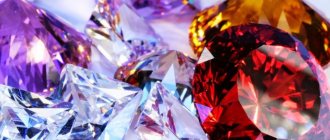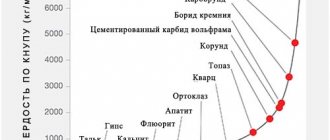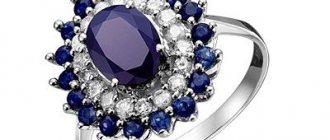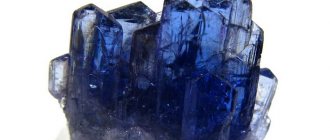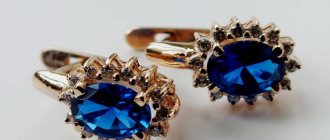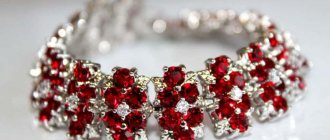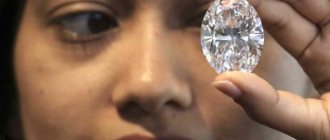There is a phenomenon in our country that most of those who are at least a little familiar with precious stones are trying to buy a natural, non-diffusion sapphire or other gem. Many methods for refining minerals are included in classification tables, and new processing methods are being invented every day. What is this connected with?
As precious stones are mined in nature - and this happens quite quickly - their supply on earth is exhausted. Since many of them are not of sufficient quality even for use in inexpensive jewelry, and there are few high-quality stones, it is impossible to satisfy the appetites of everyone.
Diffusion sapphires
Moreover, many are ready to buy a natural gem of not very good quality rather than give preference to a processed one, but in vain. There are thousands of processing methods, including diffusion, and not all of them somehow worsen the quality of the mineral and make it not real. In some cases, this cannot be avoided at all, for example, with sapphires with optical effects; therefore, it cannot be said that ennoblement is evil. Moreover, it is not entirely correct to divide stones according to processing methods into natural and not.
Be that as it may, mechanical processing is often removed from the list of methods for refining stones. But it also affects the surface layers of the mineral, as, for example, in the case of titanium diffusion. This happens because the stone heats up during processing. But the first means a completely unprocessed natural stone, and the second means almost a fake. Therefore, it is more competent to consider the question of what kind of processing was used and how this affects the cost of the product.
Diffusion treatment of sapphires
Stones of gem quality and large size are rarely found in nature. Therefore, most of them are processed to give them at least some kind of marketable appearance. In some cases, this approach is normal, but sometimes it changes the appearance of the stone for a short time and, due to some exposure, may deteriorate.
In order to process the stones, they are heated to high temperatures. This is necessary both in the case of internal and external diffusion. Even to fill cracks in a stone with something, they heat it.
The latter is used to improve the transparency of the stone. The same can be achieved by ordinary heating without impurities. As the temperature of the sapphire increases, many inclusions melt, and some of them have the ability to fill cracks. Corundums are purified by reaching a temperature of 1200 degrees.
Another purpose that is pursued when heating stones is to enhance color. Most minerals are naturally pale and uneven in color. Any color stones get is given by the impurities they contain. During heating, such impurities begin to diffuse throughout the volume of the stone and are evenly distributed, which makes the shade of the mineral more expressive.
The last treatment method is the diffusion of a substance that enters the stone from the outside. This usually happens as follows. During heat treatment, the stone is coated with a special flux to which a substance can be added. Depending on what effect is being sought, it may be beryllium, chromium, iron, titanium or lithium.
The best effect is achieved with diffusion staining with beryllium and lithium. These substances have a fairly small atomic size, which allows them to penetrate deep enough into the mineral itself, so the coloring is uniform. But even in this case, not everything is so simple. The dye mainly fills small cracks, so the final effect depends on the initial location of these same cracks. In addition, many impurities that affect the color and structure of the stone remain unchanged in this case, so high-quality processing is obtained for some specific minerals.
Previously, it was believed that all sapphires that contain beryllium were processed. But not so long ago it was discovered that some of them initially contain it. Therefore, the assumption was made that natural sapphires should contain no more than five ppm of beryllium.
Not long ago there was some scandal associated with sapphires. In 2001, unusual orange sapphires began to appear on the market; as it later turned out, these were pink stones that had been treated with beryllium diffusion, although many experts claimed that the stones were real.
Titanium, chromium and other substances color sapphire only superficially, and we are talking about fractions of a micron. Such a thin coating can come off with any, even relatively minor, impact. When remodeling or re-cutting the stone, it also goes away.
Jewelry with diffusion sapphires
Identification of such staining is also not a big problem. It is enough to consider the stone in immersion liquid or in diffuse color.
Mineral cut
In order for the sapphire to acquire a beautiful presentation, it must be prepared. For this purpose, a cutting process is used: the facet method or the cabochon method. In the first case, the following forms are popular:
- round;
- oval;
- "heart";
- "marquis";
- "pear";
- "emerald".
Cabochons are predominantly used on large minerals. During this cutting process, the stone is given a round or oval shape. The top is polished. The result is an attractive glossy shine. The method is also relevant when working with opaque sapphires that have defects.
If you get your hands on a “star-shaped” stone, the cabochon cut will allow you to use the needle-shaped inclusion to give an interesting asterism effect. The result is a mineral with many rays on the surface.
Sapphires with optical effects
As you know, sapphires that have noticeable optical effects, most often a star in the center of the stone, have a high price and popularity. They are cabochon-cut to highlight the beauty of the phenomenon, and many wonder whether such stones are treated.
Raw corundums of natural origin contain thin needles of rutile in the form of whiskers. Effects such as silk, which looks like a spread of thin needles throughout the thickness of the stone, as well as asterism and cat's eye appear due to the heating of these stones. This happens due to the dissolution of the rutile whiskers and the release of empty tubules from under them.
If the stones are processed in a cabochon with hexagonal symmetry with the lower base perpendicular to the axis of the hexagonal cell, this leads to this effect. It turns out that if the rutile from the tubules is not dissolved, then they are almost invisible. In order to display these effects clearly, it is necessary to heat treat the mineral.
Thus, when purchasing star corundum, you can be sure that it is processed. Otherwise, the star appears barely and is very blurry. If the stone initially contained a lot of rutile, then it was simply heated in borosilicate flux; if there was little rutile, then titanium oxide was added to the flux. The main thing here is the orientation perpendicular to the main axis of the crystal.
Many buyers are assured of the natural origin of the mineral, which has a clearly visible star. Moreover, you can often hear that such high-quality and untreated stone can only be purchased from them, while the rest sell diffusion stones. You should not believe such a statement. In any case, the stone is processed, and if not, then it is most likely synthetic.
Place of Birth
In the photo: map of sapphire deposits
It happens that the cost of sapphires is also influenced by the factor of geographical origin (place of extraction). The best blue and blue sapphires were historically mined in the north of India in the state of Kashmir, but at the moment the development of this deposit has ceased. Therefore, Kashmiri specimens are now very difficult to find on the market; their sale is mainly carried out through auctions. Kashmiri specimens are characterized by a rich blue color and the presence of velvety tints due to the content of a large number of rutile inclusions. Keep in mind that the word "Kashmiri" is now used for sapphires not only to indicate their geographical origin - sapphires are from Kashmir, but also to describe the characteristic "Kashmiri" color of a sapphire, and the stone itself may have other origins. Blue and cyan sapphires from Myanmar (Burma) are in second place in value. Then sapphires from the island of Sri Lanka (Ceylon). Sapphires from Kashmir, Ceylon and Burma are the main three “brand” deposits for sapphires, famous for their high quality. Sapphires of excellent blue color have recently begun to arrive from the deposits of Madagascar. Sapphires from Thailand, Cambodia, Laos, and Australia are usually represented by specimens that are too dark and not very large in size. It is worth knowing that some “Cambodian” stones sold on the market near the Pailin deposit (Cambodia) were brought there from other countries. Dark Australian sapphires are widely found in mass-produced jewelry. Vietnamese corundums can also be found on the world market. There are also deposits of sapphires in Africa, for example, in Tanzania and Nigeria, but the color of local samples usually also cannot be classified as good.
Sapphire processing codes
Very often, corundums must be processed, because there are practically no ideal specimens in nature, and if there are any, they are very expensive. In addition to heating and diffusion, I cure sapphires with glass and so on. Depending on how the sapphire was processed, the documents will indicate codes that mean the following:
- N - unprocessed. This category includes almost all stones that naturally have a color changing effect. In addition, stones of either very light colors or very dark colors are not processed. Of course, if the color of the gem is saturated, then unprocessed it will be expensive. Signs that can be seen with the naked eye: multi-color corundums have a sharp border, high transparency, dim color.
- H - heat-treated stone. Produced to improve color. Usually done under a layer of borosilicate flux to prevent the crystals from being contaminated by background impurities.
- U—ennobled by diffusion. Typically titanium, beryllium or lithium diffusion is used. The latter does not allow itself to be detected by many methods available to gemologists.
- F - corundum with crack treatment. Most often, lead glass is used for this, which is a glassy melt of lead oxides with high strength and hardness. Usually this category of stones is the cheapest.
History of the invention of stone
Sapphire is a rare find in nature, its reserves are limited. Known since ancient times, the stone remains popular to this day. By the end of the 19th century, the problem became acute. This required replenishing the jewelry market with new jewelry.
Many chemists and physicists dealt with the issue of creating artificial stone. As a result, in 1907, Verneuil managed to grow a crystal under artificial conditions. To do this, he used aluminum oxide and a torch flame. Synthetic sapphires are still produced in laboratories using the Verneuil method.
Signs of diffusion treatment
In order not to get caught and not to purchase a diffusion sapphire at the price of a natural one, you need to know the methods of distinguishing and the characteristics of processed sapphires.
First of all, we will talk about heated stones, since this method of processing can also be classified as diffusion, but not external, but internal, when the coloring pigment spreads throughout the thickness of the stone. Signs of this are:
- Corundums have a blue tint and have uniform clouding of the crystal with microdefects that will only be noticeable through a magnifying glass with 20x magnification. Around such microdefects, halos, spherical, flat, and others can be formed.
- Heat-treated sapphires and rubies contain local, heterogeneously distributed clouds of halo and red wool.
- Sometimes the result of thermal annealing is also the healing of microscopic cracks, in which case, at high magnification, drops of flux can be seen in them. There may be white tubules from dissolved rutile.
Signs of diffusion treatment are:
- The diffusion of titanium in some cases is manifested by the expansion of star rays in corundums with the effect of asterism. Blue surface diffusion sapphires have a specific color that hardly changes under different lights.
- Beryllium leaves only one trace, and not always. Around the rudiment of the processed stone, you can see an outline of a different color, neighboring on the spectrum. The absence of such a contour does not indicate untreated sapphire, but its presence clearly indicates treatment with beryllium.
- There are no signs of lithium tinting of corundum, visible without instruments.
In most cases, there is nothing wrong with diffusion treatment of sapphire. If this is done with high quality and at the highest level, and lithium and beryllium were used for coloring, then such an effect will be completely unnoticeable. The disadvantage is that red ruby and blue sapphire cannot be produced with these substances, and the methods used to dye corundums in these colors have less long-term effects.
Color Enhancement
This becomes possible by filling the cavity with a coloring pigment. The substance used is oil-based dyes. Sometimes an aqueous or alcohol solution is used. The method is imperfect - the contour shade is unstable. In this case, the dye can leak out during the use of the stone. To check for the presence of pigment, you need to take a cotton swab soaked in acetone and press it against the surface of the sapphire. A painted specimen will definitely leave a mark.
Most often, sapphire stones are classified into natural and imitation. Moreover, a lot depends on the processing. If a beryllium-based method is used, the mineral is classified as a natural stone. When filling a cavity with lead or silicate, as well as carrying out diffuse manipulation based on titanium or chromium, the product is considered an imitation.
Definition of "low" temperature
While some dealers we spoke with defined low-temp processing as processing at temperatures below 1000°C, for research purposes we defined it slightly differently. High temperature processing involves the dissolution of microcrystals, while low temperature processing does not. The most common of these microcrystals in corundum is rutile. Rutile dissolution can occur at a temperature of 1200-1350°C, which we use to determine the approximate boundary between low and high temperature treatments. Therefore, we focused our experiments on four "low temperature" rounds with temperatures ranging from 800 to 1100°C, one "intermediate" round with a temperature of 1300°C, which we can consider the border region, and one "high" round with a temperature of 1500°C for contrast.
Samples
Twelve untreated Madagascar blue sapphire samples from three deposits were prepared for heating experiments. Specimens 1-4 were collected by one of the authors of the paper in 2022 in Bemainti, Madagascar. Samples 5-8 were acquired by Lotus Gemology during a 2016 trip to Ilacaca, Madagascar. Samples 9-12 were obtained in Bangkok from a large quantity of rough sapphires from Andranondambo. All stones were examined before heating and showed characteristics consistent with untreated Madagascar sapphire.
